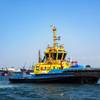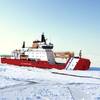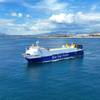Vessels: What’s in Store for 2004?
By Larry Pearson
The 2003 workboat construction market had its ups and downs and at best has given mixed signals about 2004 and beyond. Among the various workboat vessel segments, passenger vessels, excluding ferries and inland waterway vessels such as tugs and push boats, are in a static mode. Vessels will be built in 2004, but at a pace constant with years past.
Some markets such as the building of patrol boats and other vessels with national security implications appear are sure bet winners for 2004 with several shipyards with large contracts that have deliveries stretched out for two years or more in some cases.
Another market that continues to grow is high-speed aluminum passenger ferry and the slower passenger/vehicle ferries. Shipyards along the east coast such as Derecktor and Gladding Hearn have full order books despite the slower rate of growth for ferries for the New York City area. In 2002 and 2003, many ferries were delivered to this area replacing the PATH and other subways destroyed in the World Trade Center explosion. This rate of delivery will slow in 2004 and beyond.
Offshore Oil & Gas
One of the bigger market mysteries is support vessels for offshore oil and gas. The last two years have seen an unprecedented growth in vessels delivered to this market. The major support vessel fleets owned by Tidewater, Hornbeck, Seacor, Otto Candies and others has built supply boats and crew/supply boats by the hundreds.This rapid build up in these fleets was based on the assumption that the drilling malaise would end in late 2003 and the boom times would be on with a vengeance. This obviously has not happened as of yet, even though underlying economic conditions for the rebound have been in place for several months now.
For example, earlier this year the Department of Interior introduced a royalty relief program for the drilling for "deep gas" on existing leases in the Gulf of Mexico. New 3-D and 4-D imaging technology indicate substantial deposits of natural gas can be found on existing leases on the Continental Shelf below 15,000 feet. As an incentive for oil companies and drilling contractors to search for this gas, the Interior Department through the Minerals Management Service will offer substantial royalty relief for bringing this gas to the surface. The implication of the program for supply boat owner/operators is significant. Deeper wells need more liquid mud and other chemicals than conventional 10,000-foot deep wells and this material can only be brought to the drill site by supply vessels. Anticipating this need for a new type of supply boat with great mud holding capacities, most boat operating companies designed vessels that maxed out below deck tanks. For example, four companies ordered nearly a dozen new supply vessels from Bollinger Shipyards, Lockport, La. that carries over 6,000 barrels of mud in a 207-ft. long boat. So far deliveries have been made to C & G Boats, Seacor and the first of four vessels for Tidewater is nearing completion. The mud hauling frenzy even hit the crew/supply boat market as a new design by Tidewater included the ability to carry 1,000 barrels of liquid mud in addition to the usual fuel oil and water cargos. Tidewater has taken delivery of four of these 175-ft. vessels with another four under construction, all by C & G Boat Works, in Mobile, Ala.Edison Chouest Offshore (ECO), Galliano, La., who both builds and operates a large fleet of offshore oil vessels in the Gulf of Mexico has responded to specific needs of one of their largest customers, Shell Oil Company. Earlier this year ECO delivered the Laney Chouest, reportedly the largest offshore vessel ever built. This vessel is an Anchor Handler Tug Supply vessel (AHTS) that was built specifically to tow rigs from place to place in the Gulf and to set suction piles that anchor floating platforms to the seabed.
ECO also built a series of four 280-ft. supply boats with liquid mud capacity in excess of 15,000 barrels. These vessels are designed for deep-water work, but with their huge liquid mud holding capacities, the ability to serve multiple rigs drilling for deep gas gives these vessels a multi-mission capability.
However, drilling companies have yet to respond with the type of concerted activity expected. "We are working on it," is the typical response in a recent round of questions to major oil companies and drilling contractors.
Two other conditions are favorable for additional drilling that leads directly to increased utilization of the offshore oil support fleet. Oil prices have remained in the $25-30 per barrel range in 2003 and there seems to be no predictable influence to change that anytime soon. Secondly, the natural gas supply demand equation has been out of balance for the past several months. The cost of gas per million cubic feet is twice what it was 12-15 months ago and the supplies are at a very low point.
With stability in the price of oil and gas supplies "tight", increased drilling activity was anticipated to begin in late 2003, but has not. Add to this equation the fact that subsea construction work is at an all-time high and is expected to stay high for the next 4-5 years.
New construction activity in the supply boat market for 2004 is not expected to match the 50-60-boat level of the past few years. The one major contract that will result in deliveries in 2004 and 2005 is the 10-vessel order Rigdon Marine, New Orleans, La. has with Bender Shipbuilding and Repair, Mobile, Ala.
"We hope the worst times are behind us," said Bob Alario, president of the Offshore Marine Service Association (OMSA), a trade group of offshore vessel owners and operators.
"All the conditions are right for significant increase in drilling activity," Alerio added. "Everything is there for this market to simply explode. The prices are there, the equipment is available, the technology is there and even the shortages are right," Alerio added. "The only thing I can bet on is that when the prognosticators said business would get better, things got worse and the reverse is also true based on recent history. So with all the negative talk, maybe things will actually improve," Alerio suggested
Patrol Boats
While the offshore oil industry slowly gears up for more drilling, one vessel market is here and now, "agoin and a blowin" to borrow a colorful phase from oil field booms of the past. That market is vessels for homeland security.
The charge here is being led by the needs of the military; especially the Coast Guard to better protect our 95,000 miles of coastline. This increased activity has had a huge impact on the order books of many shipyards.
For example, Bollinger Shipyards is well underway on the rework of the 49 Island Class patrol boats they built in the 1990's. The 110-ft. vessels will be lengthened by 13 ft. to accommodate a new RIB that will be able to deploy and be recovered via a stern ramp. Other highlights of the reconstruction program is that the entire superstructure of the vessel will be replaced with the skeleton being built by VT Halter and barged to Bollinger. The latest electronics will be installed in the aluminum superstructure along with new berthing arrangements allowing the Coast Guard to comply with its mandate for mixed gender crews. Five of the vessels are now at Bollinger in the $200 million program anticipated to last for several years.
The rework of the Island Class patrol boats is the first step in the $17 billion Coast Guard "Deepwater" program that will add almost 100 ships and scores of fixed wing and helicopters to the fleet of the Coast Guard.
In mid November, Bollinger Shipyards will deliver their 100th patrol craft, an 87-ft. patrol craft for the Coast Guard. Bollinger had built 50 of these vessels in the past and their contract was extended by up to 13 additional vessels and the Sea Lion is the 100th patrol vessel built by Bollinger for the Coast Guard.
The market for patrol boats has gone far beyond the military. State and local law enforcement agencies have been good customers for shipyards turning out the 25 to50-ft. patrol craft. SeaArk Marine, Monticello, Ark., has been especially active with law enforcement agencies of several states that use these vessels for a wide range of patrol activities including fisheries enforcement, harbor patrol and other such missions.
You can bet that several more contracts will be let in 2004 and beyond for patrol craft.
Ferries
Ferry boats were on everyone's mind in late 2001 and 2002 as the industry responded to New York City's immediate need for ferries to replace the demolished infrastructure left by the attack upon and subsequent collapse of the World Trade Center towers.
Even before that, the ferry business was the only growth market in the passenger vessel industry as taking the ferry started to make sense to thousands more people caught in the constant gridlock of autos on city streets. As has been the case for the past several years, Gladding-Hearn Shipbuilding, Somerset, Mass. and Derecktor Shipyards, Mamaroneck, NY continue to build a wide variety of all aluminum fast ferries for a growing client base. These vessels also include pilot boats, whale watch vessels as well as ferries.
There is one major contract in the "slow" vehicle/passenger ferry market that will happen in 2004. That is for the construction of three Kennedy Class ferryboats for New York City, capable of holding 4,300 passengers plus 38 cars. The first of these ferries was launched from Marinette Marine, Marinette, Wis..
These new ferries will replace three 40-year old vessels, one of which was involved in a recent accident killing 12 persons when it struck an adjacent pier before docking. The first of these three vessels is to be delivered in June 2004.
The future of the fast ferry business, from a cost per vessel standpoint, may lie in the military. Both INCAT of Tasmania and Austal Ships have huge catamaran ferries that can hold troops and their motorized equipment for fast deployment anywhere in the world. When the Army, Navy and Marines finish their evaluation on vessels leased from INCAT and Austal, they are expected to purchase as many as 25 of these 30,000 hp vessels.
Bollinger Shipyards, who has a joint venture with INCAT may build a new production facility designed exclusively to build these vessels. Bollinger President Boysie Bollinger wants to build this facility in Louisiana but questions if he can get the 3,000 workers expected to staff this plant if it is built in Louisiana.
Inland Waterways
The market for push boats and tugs has stayed relatively steady for the past few years. Although there are new builds, much of the activity in this market is repowerings and reconstruction as companies try to squeeze additional life out of these hulls.
The construction activity of Articulated Tug Barge (ATB) units has slowed from the level of a couple of years ago. The double hulling of barges continues and its pace may increase as there is talk of tightening the OPA-90 time schedule of the double hulling of existing barges. Originally many barges had dates of 2010 to 2015 for adding a second hull or being tied up, but if the deadline is to be earlier, many barges with useful life will start moving into shipyards years earlier.
Other Markets
During 2003 major vessels were delivered in the fireboat market and the U.S. flagged overnight cruise market. Unfortunately, only one major vessel of each type was delivered and interestingly one shipyard built them both.
Nichols Brothers, Whidbey Island, Wash. delivered a super capacity fireboat to the Port of Los Angeles and a 360-ft. overnight excursion paddlewheeler to American West Steamboat, Seattle, Wash. One market with significant growth potential is that of megayachts, those private yachts that carry price tags of at least $5 million with many at $20 million or more. The U.S. is the second largest producer with 91 in 2002, behind Italy's 212.
The largest builder of these floating palaces is Trinity Yachts, New Orleans, La. "Trinity produces about four of the vessels a year, with an average construction time of 18 months," said Billy Smith, VP of Trinity. "Typically our customers have a net worth of at least $100 million or five times the cost of the vessel," Smith added. The success or failure of the workboat market in 2004 depends on several factors prime of which is the extent of the recovery of drilling in the Gulf of Mexico. Also important are expected orders for more patrol boats and a continuation of orders for ferries.













